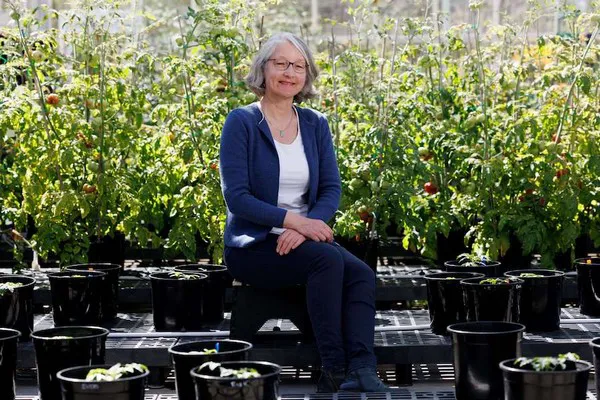The shape of a tomato is more important than many of us realize. While some breeding programs focus on disease resistance, higher yield or drought tolerance, University of Georgia plant geneticist Esther van der Knaap and her research team are one step closer to elucidating the protein interactions that regulate the fruit shape of tomatoes.
“The whole appearance of the produce has to be correct for the particular market class, so a slicing tomato has a different shape than a tomato that you use for stews and soups or one that you consume as a snack. Consumers recognize that, but there are also practical reasons for tomato shape selection,” Van der Knaap said. “Both from a consumer's point of view when buying fresh produce in the store and for processors, the shape and the size of the tomato is important. You can develop the best, disease-resistant variety, but if it doesn’t have the right dimensions for its intended use, it might not take off as a new variety for the market.”
 Plant geneticist Esther van der Knaap’s lab recently published a study that identifies the protein interaction connected to the control of organ shapes in a number of plant species, including tomatoes. (Photo by Andrew Davis Tucker/UGA)
Plant geneticist Esther van der Knaap’s lab recently published a study that identifies the protein interaction connected to the control of organ shapes in a number of plant species, including tomatoes. (Photo by Andrew Davis Tucker/UGA)
College of Agricultural and Environmental Sciences Professor Van der Knaap has been researching the molecular and genetic determinants of fruit shape for about 20 years with the goal of equipping plant breeders with the information they need to produce the most desirable traits in fruit.
“The more we know about how shape is regulated in tomato, the more tools we can give to breeders working in other crops,” said Van der Knaap, explaining that different types of plants — tomatoes and peppers, for example — have the same structural features and pattern of genes.
A new study from Van der Knaap’s lab in the Institute of Plant Breeding, Genetics and Genomics, recently published in the journal New Phytologist, identifies that the interaction between TONNEAU1-recruiting motif proteins (TRMs) and ovate family proteins (OFPs) are connected to the control of organ shapes in a number of plant species, including tomatoes. However, the function of the TRM-OFP interaction in regulating shape is unknown.
“That is the knowledge we are creating. A few years ago, we published on one gene in the TRM family that influences shape, but it turns out that there are many more subtleties. Now we have found that there are several other TRMs from the same family that have a function in determining fruit shape,” Van der Knaap said.
These new findings indicate that the TRM family of proteins appear to have roles in the shape of the fruit a plant produces. Because different genes control fruit growth on different axes — think wide or tall — breeders can begin to apply Van der Knaap’s research into controlling fruit shape with disease-resistant genes to come up with optimal market varieties for each type of fruit.
“My lab does not directly breed for new varieties, but with this research, we've given breeders tools to do exactly what the market requires,” Van der Knaap said. “If we need to create a certain shape, now we know the key parts that contribute to that. If you can — very early in the breeding cycle — already make sure that the fruits are going to be of the right size and the right shape, then the breeding cycle can be sped up. That's the application of our research.”
While Van der Knaap’s team demonstrated that TRM-OFP protein interactions affect shape, the changes were more subtle than expected.
“The mutations in both OFP and TRM were expected to have a strong effect on shape. But it turns out that the effect is very subtle, and that tells us that we have to dig a little deeper to figure out the other components of shape,” she said. “We expect that the TRM-OFP protein interactions occur in many plants, and therefore, any research that sheds more light on this process should uncover more about the regulation of plant cell division.”
Source: caes.uga.edu
